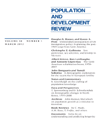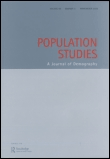
Journal of Demographic Economics
Scope & Guideline
Advancing Insights at the Intersection of Demography and Economics
Introduction
Aims and Scopes
- Demographic Change and Economic Outcomes:
The journal explores how shifts in population structure, such as aging populations, migration, and fertility rates, impact economic performance, labor supply, and social welfare systems. - Intersection of Gender and Economics:
There is a strong emphasis on gender-related issues, including the effects of women's education and labor participation on family dynamics and economic development. - Impact of Migration on Host and Home Countries:
Research is focused on the effects of migration on both the receiving countries and the migrants' countries of origin, including labor market impacts and remittances. - Health Economics and Demography:
The journal frequently addresses health-related topics, examining how demographic factors such as age and gender influence health outcomes and healthcare access. - Socioeconomic Inequality and Demographic Trends:
Papers often analyze the relationship between demographic changes and socioeconomic disparities, looking at issues such as income inequality, access to resources, and social mobility. - Longitudinal and Cross-Country Comparisons:
The journal employs a variety of methodologies, including longitudinal studies and cross-country comparisons, to understand demographic trends over time and their economic implications.
Trending and Emerging
- Migration and Refugee Studies:
Recent publications highlight the effects of migration and refugee status on health, education, and economic well-being, indicating a growing interest in understanding the complexities of migration in a global context. - Gender and Economic Empowerment:
There is an increasing focus on the intersection of gender, education, and economic outcomes, particularly in developing countries, as researchers explore how women's empowerment affects demographic trends. - Health Economics in the Context of Demographics:
Emerging themes include the analysis of health interventions and their demographic implications, such as the impact of maternal health programs on child outcomes in various contexts. - Climate Change and Migration:
An increasing number of studies are addressing the relationship between environmental factors and migration patterns, reflecting the urgency of understanding demographic shifts in the context of climate change. - Social Mobility and Family Dynamics:
Research is trending towards understanding how family structures, socio-economic status, and educational attainment influence social mobility, particularly in relation to changing demographics. - Data-Driven Approaches to Inequality:
The journal is seeing a rise in data-driven studies that analyze the effects of demographic changes on economic inequality, utilizing advanced statistical methods and large datasets.
Declining or Waning
- Traditional Fertility Studies:
There has been a noticeable decline in research specifically focused on traditional fertility studies, such as straightforward analyses of birth rates without the integration of socioeconomic factors or broader demographic contexts. - Single-Factor Economic Analyses:
Papers that analyze economic outcomes based solely on demographic factors without considering the interplay of multiple variables or contextual factors have become less prevalent. - Historical Demographics without Current Relevance:
Research that solely focuses on historical demographic trends without connecting them to contemporary issues or implications for current policy is less common. - Overemphasis on Quantitative Methods:
There is a gradual reduction in studies employing purely quantitative methods without qualitative insights, as the journal increasingly values interdisciplinary approaches and mixed-methods research.
Similar Journals

Papeles de Poblacion
Advancing demographic insights for a global audience.Papeles de Población, published by the Universidad Autónoma del Estado de México, is a prominent open-access journal that has been advancing the field of demography since its inception in 1997. With an ISSN of 1405-7425, this journal aims to foster a deeper understanding of population studies through research articles, reviews, and critical analyses that address the complex dynamics of demographic changes, social structures, and their implications. While currently ranked in the fourth quartile of its category in 2023, it serves as a significant channel for researchers, professionals, and students to disseminate and access cutting-edge findings. Open access since 2004, it provides a platform for broader readership and knowledge sharing, thus contributing to the global discourse on population issues. Based in Mexico, the journal is committed to embracing diverse perspectives, emphasizing the importance of regional studies within a global context.

MONTHLY LABOR REVIEW
Unpacking Trends in Workforce InnovationMONTHLY LABOR REVIEW is a distinguished journal published by LEGAL BOOKS DEPOT, focusing on the dynamic intersections of management, human resources, and innovation within the workforce. Established in the United States, this prominent journal offers insights drawn from a rich history of coverage dating back to 1945, although its Scopus indexing has seen modifications over the years, with the most recent coverage discontinuation in 2021. With a current category quartile ranking of Q3 in Management of Technology and Innovation, Organizational Behavior and Human Resource Management, and Strategy and Management, the journal is positioned within the competitive landscape of business and management research. The Scopus rankings further emphasize its relevance, ranking in the 34th percentile for Organizational Behavior and Human Resource Management, and the 33rd percentile for both Strategy and Management fields. Researchers, professionals, and students seeking to explore the evolving trends in labor relations and workforce innovation will find this journal an invaluable resource for scholarly articles and practical insights that contribute to the field.

Regional Statistics
Illuminating Trends with Rigorous Statistical ResearchRegional Statistics, published by the Hungarian Central Statistical Office, is a leading scholarly journal that plays a pivotal role in enhancing the understanding of regional development and statistical analysis. With its ISSN 2063-9538 and E-ISSN 2064-8243, this open-access journal contributes significantly to various fields, including Cultural Studies, Economics, Geography, and Public Administration. The journal has established itself with impressive Scopus rankings, placing it in the top percentiles across multiple categories, evidencing its high-quality research outputs. Covering converged years from 2015 to 2024, Regional Statistics publishes insightful articles that address pressing regional issues, making it an invaluable resource for researchers, professionals, and students alike who are interested in the quantitative dimensions of society. With a reputation bolstered by its Q1 and Q2 categorizations in various disciplines, this journal is not only committed to advancing statistical knowledge but also to fostering interdisciplinary dialogue among statisticians, policymakers, and social scientists.

Spatial Demography
Mapping the Dynamics of DemographySpatial Demography is a vital academic journal published by Springer International Publishing AG, focusing on the intersection of spatial analysis and demographic research. With its ISSN 2364-2289 and E-ISSN 2164-7070, this journal aims to advance understanding of population dynamics through innovative methodologies and spatially explicit data, offering a platform for researchers, professionals, and students engaged in demography, geography, and urban studies. While it does not currently operate under an open access model, Spatial Demography maintains a rigorous peer-review process to ensure high-quality publications that contribute significantly to the field. Given the growing importance of spatial data in demographic research, the journal serves as an essential resource for those looking to explore how spatial attributes influence demographic processes and patterns worldwide. The official address of the publisher is Gewerbestrasse 11, Cham CH-6330, Switzerland.

Population Review
Connecting Scholars to Contemporary Population IssuesPopulation Review, published by Sociological Demography Press, is a vital resource in the field of demography, contributing to the understanding of population dynamics and trends since its inception in 1988. With an ISSN of 1549-0955 and an E-ISSN of the same number, the journal has played a significant role in disseminating scholarly research and analysis relevant to demographic changes and their implications. Although currently categorized in the Q4 quartile, it ranks 78th out of 139 in the Scopus Social Sciences: Demography category, placing it within the 44th percentile among its peers. This journal serves as a platform for researchers, professionals, and students to engage with contemporary population issues, encouraging the exploration of new theories and methodologies. While not available as open access, its robust editorial standards and commitment to rigorous research make it an invaluable addition to the libraries of demographers and social scientists alike.

POPULATION AND DEVELOPMENT REVIEW
Bridging Research and Policy in Population Studies.Population and Development Review is a prestigious academic journal published by Wiley, recognized for its comprehensive exploration of the intersections between population dynamics and development processes. Since its inception in 1976, the journal has contributed significantly to the field, featuring rigorous peer-reviewed articles that address pressing issues in demography, development, and sociology, maintaining a commendable reputation with a Q1 ranking across multiple categories as of 2023. With an impact factor that reflects its influence—ranking in the 90th percentile in Sociology and Political Science, and 85th percentile in Development—this journal serves as a vital resource for researchers, policy-makers, and students alike. It is instrumental in fostering dialogue and disseminating knowledge that shapes and informs public policy and academic inquiry. Although not an open-access publication, it remains accessible through various academic institutions, ensuring that its valuable insights are available to a broad audience eager to engage with the complexities of population and development.

GENUS
Unlocking Insights into Population DynamicsGENUS is a prestigious open-access journal published by SpringerNature, dedicated to advancing research in the field of demography. With an E-ISSN of 2035-5556, it has been operating as an open-access platform since 2016, ensuring that valuable demographic knowledge is accessible to a global audience. Located in Switzerland, this journal contributes significantly to the scholarly community, achieving a remarkable Q1 ranking in the 2023 Scopus category for Social Sciences focusing on Demography, where it stands at an impressive Rank #12 out of 139, placing it in the 91st percentile. With a history that spans several decades, starting from 1970 and including comprehensive coverage from 2007 to 2024, GENUS provides a vital forum for researchers, professionals, and students seeking to engage deeply with current demographic studies. This journal not only publishes cutting-edge research but also facilitates fruitful discussions on key demographic trends and policies, making it an essential resource for anyone interested in the social sciences.

POPULATION RESEARCH AND POLICY REVIEW
Bridging Research and Policy for a Sustainable FuturePopulation Research and Policy Review is a prestigious journal published by Springer, specializing in the fields of demography and policy analysis. Established in 1982, this journal has developed a significant reputation within the academic community, currently holding a Q1 ranking in Demography and a Q2 ranking in Management, Monitoring, Policy, and Law as of 2023. With a robust Scopus ranking of #34 out of 139 in Demography and a readership that spans multiple disciplines, this journal serves as a critical platform for researchers, professionals, and policymakers to disseminate their findings and insights related to population dynamics and policy implications. Although not an open-access journal, Population Research and Policy Review provides vital research that influences both theoretical frameworks and practical applications in social sciences and environmental management. The journal’s ongoing commitment to high-quality, peer-reviewed scholarship makes it an indispensable resource for those seeking to understand and address contemporary demographic challenges.

JOURNAL OF POPULATION ECONOMICS
Illuminating the Links Between Population Change and Economic GrowthThe JOURNAL OF POPULATION ECONOMICS, published by SPRINGER, stands as a leading peer-reviewed journal in the fields of demography and economics. Established in 1988, this esteemed journal offers a platform for high-quality research that probes the intricate relationships between population dynamics and economic phenomena. With its impressive Q1 quartile ranking in both Demography and Economics and Econometrics for 2023, the journal is recognized as a vital resource for scholars and practitioners alike, reflecting its rigorous standards and impact in the academic community. Its Scopus rankings position it within the top tiers of social sciences, making it an essential read for those engaged in demographic and economic research. Although the journal does not currently adopt an open access model, its esteemed reputation and continuous publication until 2024 ensure relevant and up-to-date findings contribute meaningfully to scholarly discourse. At its core, the JOURNAL OF POPULATION ECONOMICS aims to bridge theoretical insights and empirical findings, fostering an understanding of how population changes influence economic outcomes and vice versa.

POPULATION STUDIES-A JOURNAL OF DEMOGRAPHY
Unraveling the Complex Tapestry of Demographic ChangePopulation Studies: A Journal of Demography is an esteemed scholarly publication dedicated to advancing the understanding of demographic trends and their historical contexts. Published by Routledge Journals, Taylor & Francis Ltd, this journal has a notable impact in its field, recognized as a Q1 category journal in both Demography and History as of 2023. Its Scopus rankings highlight its significance, featuring a remarkable 12th place rank in Arts and Humanities—History and 19th place in Social Sciences—Demography, both underscoring its influential role in academic research. Established in 1947, the journal has consistently contributed to the discourse in population studies, offering a platform for innovative research and critical analysis. While it does not provide open access options, it remains a vital resource for researchers, professionals, and students who seek to explore the complex relationships between population dynamics and historical narratives. Its comprehensive coverage from 1947 to 2024 ensures a rich repository of knowledge, making it essential for anyone involved in demographic research.